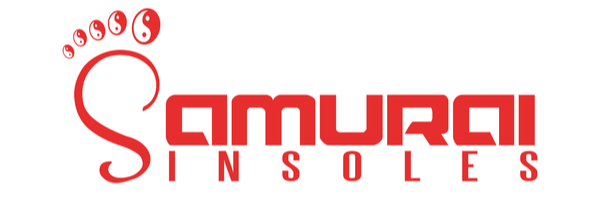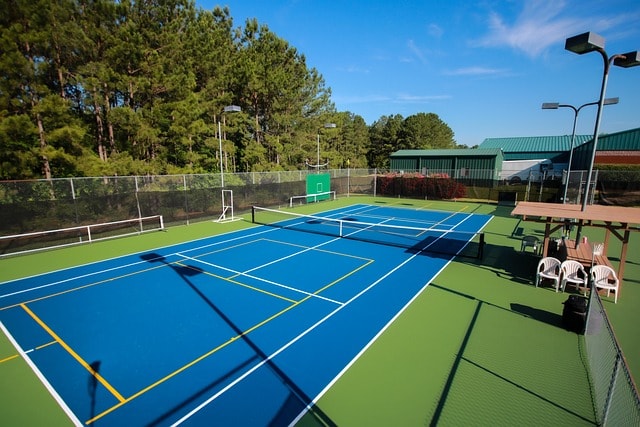Overpronation, the excessive inward rolling of your feet when you walk or run, is a common issue affecting millions. This seemingly small mechanical flaw can lead to a cascade of problems, from persistent foot pain like plantar fasciitis to knee, hip, and even back discomfort. While factors like genetics and footwear play a role, a key contributor is often weak muscles in your feet and lower legs that fail to properly support your arches.
The good news is that you can take proactive steps to address this. This guide moves beyond temporary fixes like inserts, presenting a targeted plan with the best exercises for overpronation. By systematically strengthening key muscles, you can improve your foot mechanics, enhance stability, and build a stronger foundation from the ground up. This approach directly tackles the root cause, helping to reduce pain and prevent future injuries.
Inside this article, you'll find a detailed roundup of specific, actionable movements designed to fortify your arches and ankles. We will cover everything from Towel Scrunches and Calf Raises to targeted Posterior Tibialis and Short Foot exercises. Let's dive into the movements that can help you regain control and walk with greater comfort and confidence.
1. Towel Scrunches
The towel scrunch is a foundational exercise recommended by physical therapists and podiatrists for a reason: it directly targets the small, intrinsic muscles inside your foot. These muscles, like the flexor digitorum brevis and abductor hallucis, are responsible for creating and maintaining your foot's arch. When these muscles are weak, the arch can collapse inward, leading to overpronation. By strengthening them, you build a stronger, more active support system from the ground up.
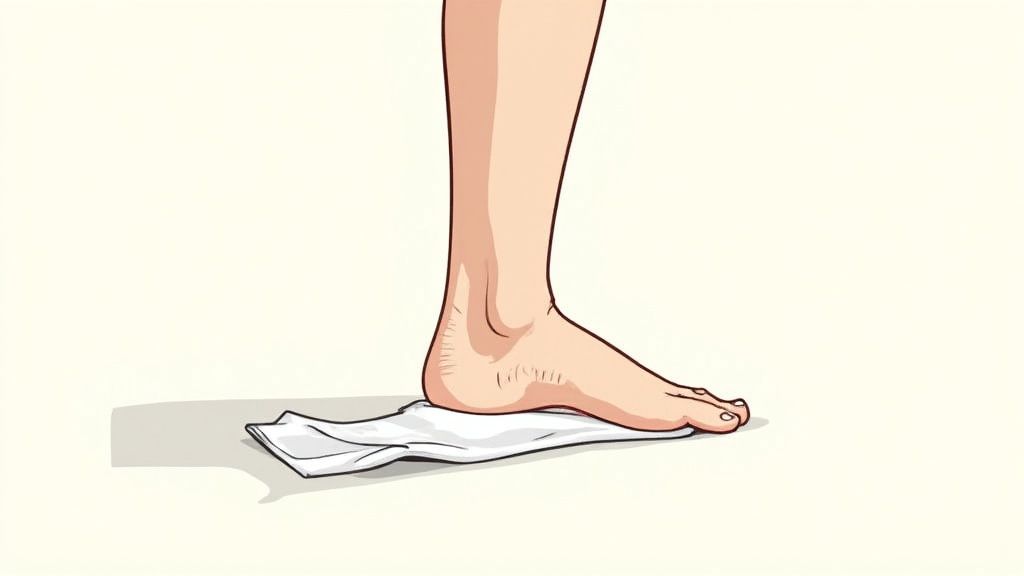
Think of it as strength training for your foot's natural "scaffolding." Just like you do bicep curls for your arms, you do towel scrunches for your arches. This is one of the most effective initial exercises for overpronation because it isolates these crucial muscles without requiring complex equipment or movements.
How to Perform Towel Scrunches
This exercise is simple to set up and can be done almost anywhere, making it easy to incorporate into your daily routine.
- Setup: Sit in a chair with your feet flat on the floor. Place a small hand towel on the ground in front of you, with the short end near your toes.
- Execution: Keeping your heel on the ground, use only your toes to grip and "scrunch" the towel, pulling it toward you.
- Focus: Concentrate on lifting and curling your toes to pull the towel. Avoid using your entire leg to drag it. The movement should be slow and deliberate, focusing on the muscle contraction in your arch.
Tips for Maximum Benefit
To get the most out of this exercise and avoid common mistakes, follow these tips:
- Start Small: Begin with 2-3 sets of 10-15 scrunches per foot. Consistency is more important than intensity, so aim to do this daily.
- Controlled Movement: The key is control, not speed. Each scrunch should be a distinct, thoughtful action. Feel the muscles in the arch and ball of your foot working.
- Progress Gradually: Once you can easily complete your sets, you can make the exercise more challenging. Try using a heavier towel (like a bath towel) or placing a small weight, such as a book, on the far end of it. Another great progression is moving on to picking up small objects like marbles or a pen with your toes.
Key Insight: The goal of towel scrunches isn't just to move the towel. It's to re-educate the muscles in your feet to actively support your arch during daily activities like walking and standing, thereby combating the mechanics of overpronation.
2. Calf Raises
While often associated with building lower leg strength for athletics, the calf raise is a powerhouse exercise for managing overpronation. It directly strengthens the gastrocnemius and soleus muscles in your calf. These muscles are critical because they connect to the heel via the Achilles tendon and play a major role in controlling the ankle and foot during movement, especially the push-off phase of your gait. When these muscles are strong, they help stabilize the ankle, preventing the excessive inward rolling that defines overpronation.
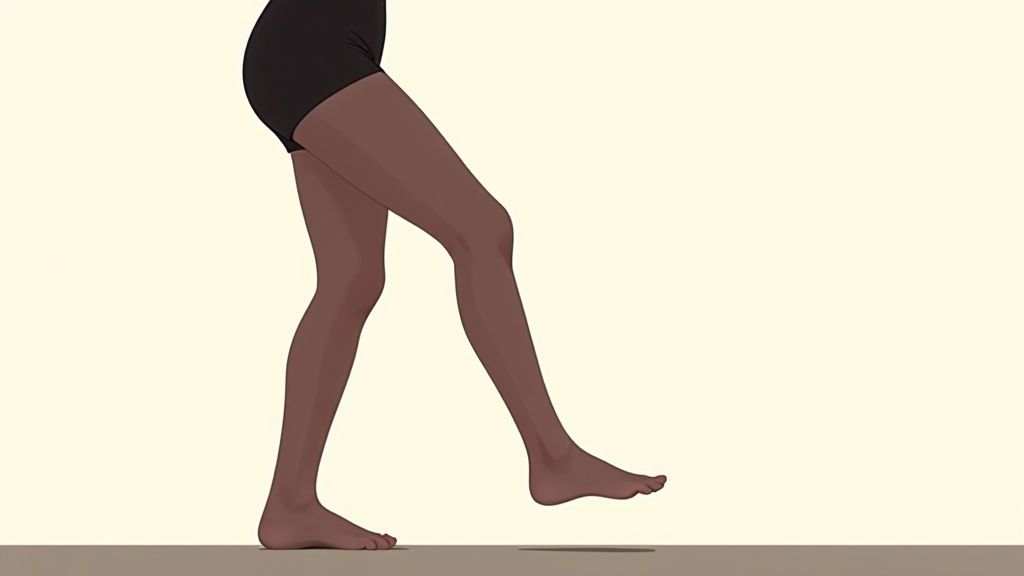
Think of your calf muscles as the primary brakes and accelerators for your foot's motion. Strong calves provide the necessary control to absorb impact correctly and power you forward efficiently, keeping your foot in a more neutral alignment. This makes calf raises one of the most essential exercises for overpronation, recommended by physical therapists and running coaches to improve biomechanics and reduce strain on the foot's arch.
How to Perform Calf Raises
This exercise can be done with just your body weight, making it accessible for any fitness level. You can use a wall or chair for balance if needed.
- Setup: Stand with your feet hip-width apart, either on a flat floor or with the balls of your feet on the edge of a step or stair. Using a step allows for a greater range of motion.
- Execution: Slowly press through the balls of your feet to raise your heels as high as you can. Pause briefly at the top, then slowly lower your heels back down to the starting position or just below the level of the step if you are using one.
- Focus: The movement should be smooth and controlled, not jerky. Concentrate on feeling the engagement in your calf muscles throughout the entire lift and lower. Avoid letting your ankles roll outward as you lift.
Tips for Maximum Benefit
To ensure you're performing the exercise effectively and safely, keep these tips in mind:
- Slow and Steady: Emphasize the lowering (eccentric) phase of the exercise. A slow, 3-4 second descent is more effective for building control and strength than a quick drop.
- Hold at the Top: Squeeze your calf muscles and hold the top position for 2-3 seconds to maximize muscle activation before you begin to lower.
- Progress to Single-Leg: Once you can comfortably perform 2-3 sets of 15-20 repetitions with both feet, progress to single-leg calf raises. This dramatically increases the challenge and better mimics the demands of walking and running, where you support your body on one leg at a time.
Key Insight: The power of the calf raise lies in its ability to improve eccentric control. This control is what helps your foot decelerate pronation as it hits the ground, preventing the arch from collapsing too quickly or too far and providing stability from the ankle down.
3. Posterior Tibialis Strengthening
While intrinsic foot muscles are foundational, the posterior tibialis muscle is the primary workhorse supporting your foot's arch. This powerful muscle runs down the inside of your lower leg, wraps behind your ankle bone (the medial malleolus), and attaches to the underside of your foot. Its main job is to pull the foot inward and upward, actively holding up the arch. In individuals with overpronation, this muscle is often overworked and weak, leading to arch collapse and a host of related issues.
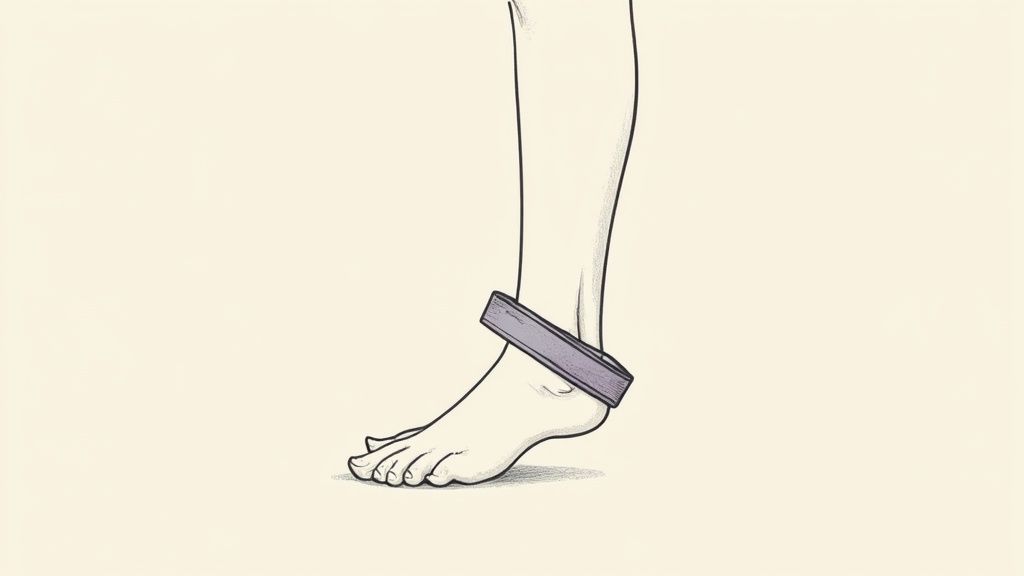
Think of the posterior tibialis as the main suspension cable for your foot's arch. When it's strong and functioning correctly, it prevents the ankle from rolling inward excessively. Directly targeting this muscle is a critical component of any effective plan of exercises for overpronation, as it addresses one of the root biomechanical failures. This approach is a standard in podiatric rehabilitation for conditions like posterior tibial tendon dysfunction and acquired flatfoot.
How to Perform Posterior Tibialis Strengthening
A common and effective way to isolate this muscle is by using a resistance band to create targeted tension.
- Setup: Sit on the floor with your legs straight out in front of you. You can also sit in a chair. Cross your affected leg over the opposite knee. Loop a resistance band around the ball of your affected foot and anchor the other end of the band with your other foot or by wrapping it around a stable object.
- Execution: Slowly and with control, turn your foot inward and downward against the band's resistance. The movement should look like you are trying to point the sole of your foot toward the ceiling.
- Focus: The movement should originate from your ankle and foot, not your entire leg. Concentrate on feeling the muscle contract along the inside of your shin and arch. Hold the peak contraction for a moment before slowly returning to the starting position.
Tips for Maximum Benefit
To ensure you're strengthening the muscle effectively and safely, keep these points in mind:
- Control Over Momentum: Avoid using fast, jerky movements. The effectiveness of this exercise comes from slow, controlled contractions against resistance, which builds muscular endurance and strength.
- Find the Right Resistance: Start with a light resistance band. You should feel a challenge but be able to complete 12-15 repetitions with good form. If it’s too easy, move to a stronger band.
- Consistent Repetitions: Aim for 2-3 sets of 12-15 repetitions per foot. For balanced support, it's wise to perform the exercise on both feet, even if only one shows significant overpronation.
- Combine with Other Exercises: This exercise works best when paired with others that support the foot's structure, like towel scrunches and calf stretches. You can learn more about a comprehensive overpronation correction plan on samuraiinsoles.com.
Key Insight: Strengthening the posterior tibialis is not just about building muscle; it's about restoring a crucial biomechanical function. A strong posterior tibialis acts as a natural brake against the excessive inward rolling of the foot, providing dynamic arch support with every step you take.
4. Short Foot Exercise
Often considered the next step after mastering towel scrunches, the short foot exercise is a more advanced technique for activating the deep intrinsic muscles of the foot. Popularized by physical therapists and movement specialists, this exercise specifically targets the abductor hallucis, a key muscle responsible for stabilizing the big toe and supporting the medial longitudinal arch. By learning to engage this muscle, you are essentially training your foot to create its own arch support from within, without relying on external aids.
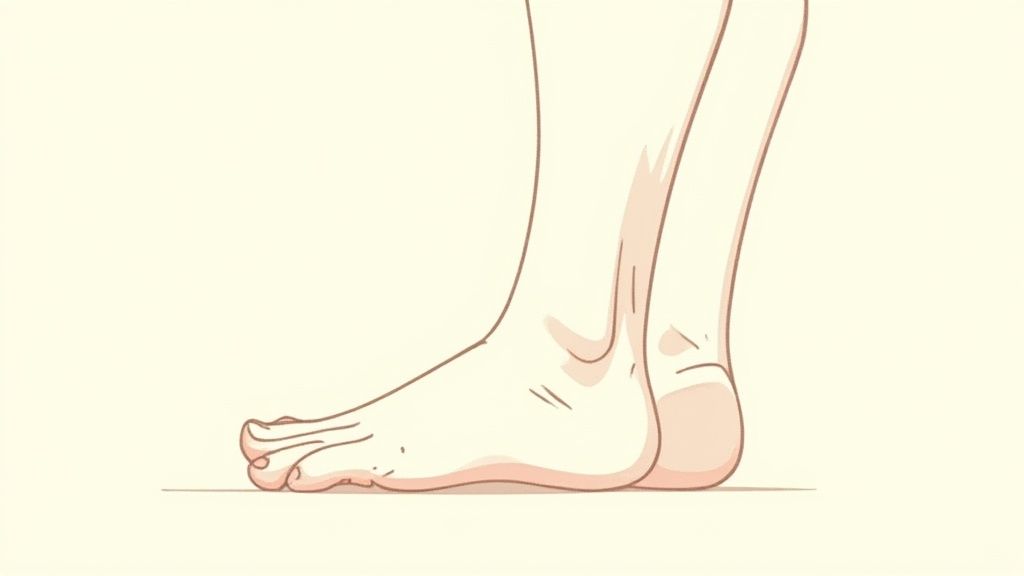
This neuromuscular exercise teaches your brain and foot muscles to work together to actively prevent the arch from collapsing. It's a subtle but powerful movement that directly combats the mechanics of a pronated foot. Mastering this makes it one of the most transformative exercises for overpronation, as it builds the foundation for better foot posture during all weight-bearing activities.
How to Perform the Short Foot Exercise
The key to the short foot exercise is the subtle contraction, not a large, forceful movement. It takes practice to isolate the correct muscles.
- Setup: Sit in a chair with your feet flat on the floor, directly under your knees. Your ankle, knee, and hip should be aligned.
- Execution: Without curling your toes or lifting your heel, try to "shorten" your foot by pulling the ball of your foot (specifically the base of your big toe) back toward your heel.
- Focus: Imagine you are trying to dome or lift your arch off the floor. The movement is very small. You should feel a deep contraction in the arch of your foot. Place a finger on your arch to feel the muscle engage.
Tips for Maximum Benefit
Precision is more important than power with this exercise. Use these tips to ensure you are performing it correctly.
- No Toe Curling: The most common mistake is curling the toes. Your toes should remain flat and relaxed on the floor throughout the movement. If they curl, you are using the wrong muscles.
- Start Seated: Begin in a seated position to learn the movement without the pressure of your body weight.
- Hold the Contraction: Once you feel the arch lift, hold the contraction for 5-10 seconds before relaxing. Aim for 2-3 sets of 10-12 repetitions per foot.
- Progress to Standing: Once you can consistently perform the exercise while seated without curling your toes, progress to doing it while standing. The ultimate goal is to be able to do it on one leg, which simulates the muscle control needed during walking and running.
Key Insight: The short foot exercise is not just a strength exercise; it's a brain-training exercise. It re-establishes the connection between your brain and the supportive muscles of your feet, teaching them to automatically engage and stabilize your arch during daily movement.
5. Arch Lifting Exercise
The arch lifting exercise, often called the "short foot exercise," is a subtle yet powerful movement that trains your brain and foot muscles to work together. Unlike dynamic exercises, this isometric hold directly targets the intrinsic muscles that support the medial longitudinal arch, the one that collapses in overpronation. By consciously contracting these muscles, you are essentially teaching your foot how to create and hold a proper, stable arch without relying on external support.
This exercise is a cornerstone in physical therapy and athletic training because it builds neuromuscular control. It’s not just about strength; it's about re-patterning how your foot behaves under load. Mastering this movement is a critical step in building a foundation for many other exercises for overpronation, as it improves your foot's ability to remain stable during walking, running, and standing.
How to Perform the Arch Lifting Exercise
This exercise requires focus and precision more than physical effort. It can be done while sitting or standing.
- Setup: Sit or stand with your feet flat on the floor, hip-width apart. Ensure your weight is evenly distributed.
- Execution: Without curling your toes or lifting your heel, try to shorten your foot by lifting your arch upward. Imagine you are trying to pull the ball of your foot back toward your heel without actually moving it.
- Focus: The movement is very small. Place a finger under your arch to feel the muscles contract and the arch lift slightly off the floor. Keep your big toe, little toe, and heel firmly planted throughout the hold.
Tips for Maximum Benefit
To master this foundational exercise and ensure you're activating the right muscles, keep these tips in mind:
- Hold and Repeat: Start by holding the contraction for 5-10 seconds, then release. Perform 10-15 repetitions per foot. Aim to practice this several times throughout the day.
- Avoid Cheating: The most common mistake is curling the toes to create the illusion of an arch lift. Keep your toes relaxed and flat. Your leg muscles should also remain relaxed; the work should come entirely from within your foot.
- Progress to Standing: Once you have mastered the exercise while sitting, progress to performing it while standing. The ultimate goal is to perform single-leg arch lifts, which dramatically increases the stability challenge and functional benefit. For more insights on similar movements, you can explore various foot stretches for flat feet on samuraiinsoles.com.
Key Insight: The arch lift isn't about creating a huge, visible arch. It’s about activating the deep, supportive muscles of the foot. This conscious activation retrains your foot to maintain its structure naturally, providing a stable base that directly counteracts the mechanics of overpronation.
6. Resistance Band Ankle Exercises
Resistance band exercises are a cornerstone of physical therapy for a good reason: they strengthen the crucial muscles that control your ankle and foot positioning. For overpronation, the focus is on the muscles that help pull the arch up and control the inward roll of the ankle, particularly the posterior tibialis and peroneal muscles. When these muscles are weak, your foot lacks the dynamic support needed to maintain a neutral position during activities like walking or running.
Think of these bands as providing targeted opposition training for your lower leg. By pushing against the band's resistance in all directions (inversion, eversion, dorsiflexion, and plantarflexion), you build balanced strength around the entire ankle joint. This comprehensive strengthening is one of the most effective exercises for overpronation because it addresses the muscular imbalances that allow the arch to collapse in the first place.
How to Perform Resistance Band Ankle Exercises
This set of exercises requires a simple resistance band and can be done while sitting on the floor.
- Setup: Sit on the floor with your legs straight out in front of you. Wrap the resistance band around the ball of one foot. To isolate the ankle, you can use your other foot or a stable object like a chair leg to anchor the band.
- Inversion (Inward Pull): Anchor the band to the outside of your foot. Slowly pull your foot inward against the band's resistance, keeping your leg still.
- Eversion (Outward Push): Anchor the band to the inside of your foot. Slowly push your foot outward, focusing on the muscles on the outside of your ankle and shin.
- Dorsiflexion (Upward Pull): Anchor the band in front of your foot. Pull your toes back toward your shin.
- Plantarflexion (Downward Push): Hold the ends of the band in your hands. Point your toes forward as if pressing a gas pedal.
Tips for Maximum Benefit
To ensure you're effectively targeting the right muscles, follow these guidelines:
- Control Both Ways: The movement should be slow and controlled, both when you are pulling against the band and when you are returning to the starting position. Don't let the band snap your foot back.
- Isolate the Ankle: Make sure the movement is coming from your ankle, not your hip or knee. Keep your leg as still as possible throughout each repetition.
- Start with Light Resistance: Begin with a light-resistance band and perform 2-3 sets of 15-20 repetitions for each direction. The goal is muscle endurance, not heavy lifting.
- Combine with Support: While strengthening your feet, using proper support can prevent further strain. For runners especially, understanding the role of supportive footwear and insoles is key. To learn more about how insoles can complement your exercises, check out this complete guide to insoles for overpronation on samuraiinsoles.com.
Key Insight: Overpronation is a multi-directional problem, and it requires a multi-directional solution. Resistance band exercises are powerful because they train your ankle to resist excessive motion in all planes, building the 360-degree stability needed for a healthy, neutral gait.
Exercise Comparison for Overpronation Correction
| Exercise | Implementation Complexity 🔄 | Resource Requirements ⚡ | Expected Outcomes 📊 | Ideal Use Cases 💡 | Key Advantages ⭐ |
|---|---|---|---|---|---|
| Towel Scrunches | Low - simple movement, easy to learn | Minimal - just a small towel | Strengthened intrinsic foot muscles, improved arch support | Foot arch strengthening, toe grip improvement, physical therapy | Inexpensive, accessible, can be done seated |
| Calf Raises | Low to Moderate - basic but needs control | Minimal to moderate - bodyweight or weights | Stronger gastrocnemius and soleus, better ankle stability | Runners, athletic training, lower leg strength improvement | Builds functional strength, easy to progress |
| Posterior Tibialis Strengthening | Moderate - requires form and resistance | Minimal - resistance bands or weights | Improved medial arch support, stronger inversion control | Overpronation correction, flat foot rehabilitation | Directly addresses root cause of overpronation |
| Short Foot Exercise | Moderate to High - requires mind-muscle connection | None | Enhanced arch height, better foot stability, improved proprioception | Advanced rehab, neuromuscular foot control | Highly effective for arch strengthening |
| Arch Lifting Exercise | Low to Moderate - isometric control needed | None | Increased arch strength, improved arch awareness | Flat feet treatment, dance, pediatric therapy | No equipment, suitable for all ages |
| Resistance Band Ankle Exercises | Moderate - proper form and band tension important | Minimal - resistance bands | Multi-directional ankle and foot strength, improved stability | Ankle sprain rehab, comprehensive ankle training | Portable, allows progressive overload |
Beyond Exercises: Your Comprehensive Plan for Healthier Feet
You now have a powerful toolkit of exercises for overpronation, from the foundational Short Foot Exercise to the dynamic resistance band movements. Mastering these exercises is the most critical step you can take toward rebuilding the muscular support system that governs your foot's alignment and function. By consistently performing these movements, you are not just treating symptoms; you are addressing the root cause of the problem by strengthening the intrinsic and extrinsic muscles responsible for stabilizing your arch.
Remember, the goal is not to perform every exercise every day. Instead, focus on creating a sustainable routine. Choose two or three exercises to focus on for a few weeks, ensuring you master the proper form before rotating in new ones. This targeted approach prevents burnout and allows you to build true strength in key areas like the posterior tibialis and the small muscles within the foot itself. The cumulative effect of these small, daily efforts is profound, leading to stronger arches, better shock absorption, and a significant reduction in the stress placed on your plantar fascia, ankles, and knees.
A Two-Pronged Approach: Combining Strength with Support
While these strengthening exercises are your long-term solution, it's important to support your feet in the present moment. Think of it like this: you wouldn't build a new house on an unstable foundation. Supportive footwear and orthotic insoles act as that stable foundation, holding your foot in a healthier, more neutral alignment while you do the work of building muscular strength.
This combination of active strengthening and passive support creates an optimal healing environment. The insoles provide immediate relief and proper alignment, which makes performing the exercises more comfortable and effective. This dual strategy ensures that every step you take reinforces good mechanics, rather than contributing to the problem.
Key Takeaway: Corrective exercises rebuild your foot's natural support system from the inside out. Supportive insoles provide immediate external support, creating the ideal conditions for those exercises to succeed. Together, they form a comprehensive strategy for lasting relief.
Your Path Forward to Pain-Free Movement
True progress comes from integrating these practices into your lifestyle. It's about being mindful of your foot posture when standing, choosing footwear that supports your goals, and committing to your strengthening routine. For those who want to dive deeper into the interconnectedness of foot mechanics and overall well-being, exploring the importance of overall foot health and strengthening can provide a more holistic perspective and advanced strategies.
Ultimately, taking control of your overpronation is an empowering journey. Each calf raise and towel scrunch is a step toward reclaiming your mobility and living without the constant nag of foot pain. Stay consistent, listen to your body, and celebrate the small victories along the way. Your feet are your foundation, and by investing in them, you are investing in a more active, confident, and pain-free life.
Ready to give your feet the support they need while you build strength? Samurai Insoles are designed by a leading podiatrist to specifically control overpronation and provide immediate relief. Pair your exercises with the medical-grade support of Samurai Insoles to create the ultimate strategy for healthy, happy feet.
